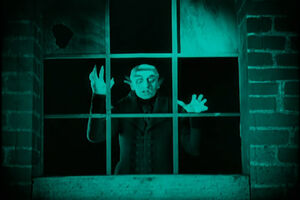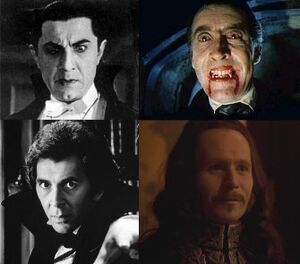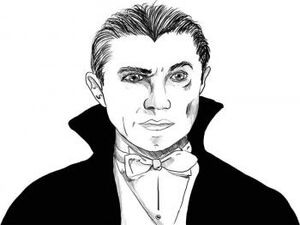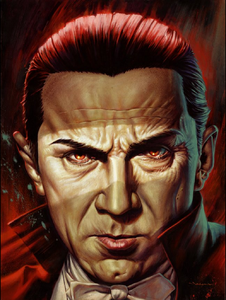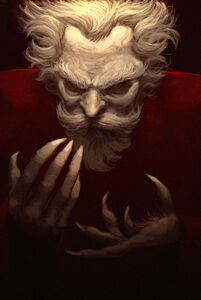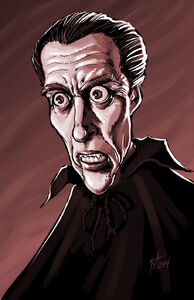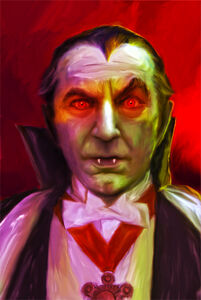mNo edit summary Tag: Visual edit |
mNo edit summary |
||
| Line 46: | Line 46: | ||
'''Count Dracula''' (his first name is never disclosed) is the titular main antagonist of the legendary novel ''Dracula'' by Bram Stoker. Universally recognized as the archetype of the vampire, he is one of the most famous fictional characters and horror icons of all time. Dracula is a centuries-old vampire, sorcerer and Transylvanian nobleman, who rules over his namesake palace known as [[w:c:evil:Castle Dracula|Castle Dracula]] and he attempts to expand his realm in England but is thwarted and destroyed by the protagonists. |
'''Count Dracula''' (his first name is never disclosed) is the titular main antagonist of the legendary novel ''Dracula'' by Bram Stoker. Universally recognized as the archetype of the vampire, he is one of the most famous fictional characters and horror icons of all time. Dracula is a centuries-old vampire, sorcerer and Transylvanian nobleman, who rules over his namesake palace known as [[w:c:evil:Castle Dracula|Castle Dracula]] and he attempts to expand his realm in England but is thwarted and destroyed by the protagonists. |
||
| + | |||
| ⚫ | |||
| ⚫ | Bram Stoker was thought to have based his character upon the historical figure {{w|Vlad Tepes|Vlad Tepes}}, ruler of Wallachia in the 15th century, also known as Vlad Dracul and "Vlad the Impaler". Unlike the vampires of Eastern European folklore - which are portrayed as repulsive, corpse-like creatures - Dracula is handsome and charismatic, exuding a veneer of aristocratic charm which masks his unfathomable evil. He is widely regarded as a metaphor for vice, depravity and illicit sex. |
||
| + | |||
| ⚫ | |||
| + | |||
| ⚫ | {{Quote|[Dracula's] face was a strong - a very strong - aquiline, with high bridge of the thin nose and peculiarly arched nostrils; with lofty domed forehead, and hair growing scantily round the temples, but profusely elsewhere. His eyebrows were very massive, almost meeting over the nose, and with bushy hair that seemed to curl in its own profusion. The mouth, so far as I could see it under the heavy mustache, was fixed and rather cruel looking, with peculiarly sharp white teeth; these protruded over the lips, whose remarkable ruddiness's showed astonishing vitality in a man of his years. For the rest, his ears were pale and at the tops extremely pointed; the chin was broad and strong, and the cheeks firm though thin. The general effect was one of extraordinary pallor.|Jonathan Harker's Journal, ''Dracula'', Chapter 2.}} |
||
| + | |||
| + | It must be noted that the most iconic portrayals of the Count depict him as a black-haired, clean-shaved, middle-aged man, in stark contrast with the old man sporting a mustache of the novel. |
||
| + | |||
| + | ==Characteristics== |
||
| ⚫ | Dracula is described as an expert scholar with immense knowledge in many scientific fields, including Alchemy. After becoming a vampire, he became a master of Sorcery and Necromancy. While his powers were later regarded as standard abilities for a vampire, the novel notes that he is exceptionally powerful and gifted, even for a vampire. As such, what abilities are his and his alone, and what are common abilities for a vampire remain unclear. Some of his powers like the ability to turn into elemental dust in the moonlight would not appear in most adaptations. |
||
| + | |||
| ⚫ | He needs to be invited to enter in an inhabited area, but as long as he has this invitation he can appear there out of nowhere. He can also enter through cracks and interstices as small as a hair. However, he would be trapped in his vault should a wild flower be placed upon it, he cannot cross a barrier made of holy wafers, and he cannot cross running waters like rivers unless the tide is at its highest or at slack levels. Finally, he must rest on the soil of his place of "rebirth" on a regular basis to sustain his powers. Such characteristic he shares with other vampires. |
||
| + | |||
| ⚫ | |||
| ⚫ | Dracula is as strong, fast and spry as twenty men. He can see in complete darkness and crawl across walls like a lizard. He can alter his aspect and features at will, though he needs to drink blood to rejuvenate and regain his youthful aspect. He is also able to change his size to an unknown extent. Dracula can shape-shift into almost any kind of feral beast and lower critter, like wolves, dogs, bats, rats and the like. He is also able to turn into mist and elemental dust in the moonlight, (the latter transformation being shared by his wives). |
||
| + | |||
| + | He is also able to control the weather to conjure storms, mist, wind and rain at will and to mesmerize people through eye contact or his mere presence. All feral beasts and critters around will obey his every command. Finally, he can control corpses and shares a psychic link with the vampires he sired. He can command them and gain access to their mind, but the process can be reversed. |
||
| + | |||
| ⚫ | Dracula, like all vampires in the novel, can be repelled by a religious symbol like a cross or by garlic. Sunlight does not harm him but he is notably weaker and unable to use his powers during the day. Should the sun rise after he shape-shifted, he would not be able to change form for the whole day. As such, the protagonists are able to hold their own in battle against him during daytime, while they admit that they would stand no chance by night. |
||
| + | |||
| + | Vampires can be destroyed by being incinerated, immersed in running water, shot with a sanctified bullet, having their heart pierced, or getting beheaded. While the most common method to pierce their heart is by using a wooden stake, iron blades can also be used, in reference to the myths where iron harms supernatural beings. However, the adaptations tend to neglect this notion. |
||
| + | |||
| ⚫ | |||
| + | Dracula is noted for having been an exceptionally brave, noble and admirable man when alive, but as an undead he is cruel, heartless and vicious, only regarding people as prey to feed on and servants to use and trample. |
||
| + | |||
| + | He is suave, refined and sophisticated, being able to seamlessly pass for a perfect gentleman, unfailingly polite and considerate, but only when he needs something from them. When he does not he proves stern and easily irked. He is very proud and haughty, as he fully expects to be shown the respect a man of his condition deserves even under his gentleman façade. He deems the protagonists’ attempts against him futile, and reacts with scathing spite when thwarted. However, he is cautious and becomes increasingly wary of them following their progress. |
||
| + | |||
| ⚫ | He is immensely intelligent and knowledgeable, with centuries of experience and learning. He prepared his plot with the utmost care, devising counters to all possible troubles. It is stated several times that another vampire trying to do the same would fail. He can quickly adapt to new cultures and situations, and proves especially cunning during his skirmishes with the protagonists. He knows how to cover his tracks, to create false leads and to misguide his foes to escape them, and he always learns from his mistakes. However, immortality somehow stunned his development, hence Van Helsing referring to his intelligence as "child-like". Indeed he will first rely on external help, before figuring that he can do better on his own and how, and he needs to experience a situation to fully grasp it. |
||
| + | |||
| ⚫ | Many adaptations make the Count a more fleshed-out, three-dimensional character. Some make him an anti-hero who laments his curse and longs for respite, and some even give him a romance with Mina. In spite of the enormous popularity of such portrayal, it must be stressed that the original Mina utterly loathes the Count. Although she does wish to save the soul of the great man he once was, she wants to see the vampire destroyed as much as the other protagonists and proves vital in his defeat. Furthermore, she breaks down in despair when infected with vampirism, and is revolted by the prospect of becoming one of his vampire brides. |
||
==Biography== |
==Biography== |
||
| Line 54: | Line 86: | ||
Using the black arts, Dracula returned from death as a vampire and lived for several centuries in his castle, with his three vampire wives for company. He is immensely wealthy, always carrying wads of banknotes and gold coins with him, being able to buy many luxurious estates like an afterthought, and hire or bribe anyone he likes. |
Using the black arts, Dracula returned from death as a vampire and lived for several centuries in his castle, with his three vampire wives for company. He is immensely wealthy, always carrying wads of banknotes and gold coins with him, being able to buy many luxurious estates like an afterthought, and hire or bribe anyone he likes. |
||
| + | ==Role in the Story== |
||
In the 19th century, Dracula enacts a long contemplated plan for leaving his scarcely populated land where everyone knows and fear him, in favor of a populated and striving country in which no one believes in vampires. It is stated that he wants to expand his hunting grounds and breed a coven of vampires, and some speculate that he plans to take over the world. |
In the 19th century, Dracula enacts a long contemplated plan for leaving his scarcely populated land where everyone knows and fear him, in favor of a populated and striving country in which no one believes in vampires. It is stated that he wants to expand his hunting grounds and breed a coven of vampires, and some speculate that he plans to take over the world. |
||
| Line 92: | Line 125: | ||
The fact that he was not "properly" staked has led some to doubt whether Dracula has really been finished off, and to even believe that he shall rise again. However, Dracula crumbles into dust with an expression of blissful relief on his face, exactly like the other destroyed vampires, and Mina loses all the physical and mental stigma caused by vampirism, proving without any doubt that Dracula was truly dead and gone. |
The fact that he was not "properly" staked has led some to doubt whether Dracula has really been finished off, and to even believe that he shall rise again. However, Dracula crumbles into dust with an expression of blissful relief on his face, exactly like the other destroyed vampires, and Mina loses all the physical and mental stigma caused by vampirism, proving without any doubt that Dracula was truly dead and gone. |
||
| − | |||
| ⚫ | |||
| ⚫ | Bram Stoker was thought to have based his character upon the historical figure {{w|Vlad Tepes|Vlad Tepes}}, ruler of Wallachia in the 15th century, also known as Vlad Dracul and "Vlad the Impaler". Unlike the vampires of Eastern European folklore - which are portrayed as repulsive, corpse-like creatures - Dracula is handsome and charismatic, exuding a veneer of aristocratic charm which masks his unfathomable evil. He is widely regarded as a metaphor for vice, depravity and illicit sex. |
||
| − | |||
| ⚫ | |||
| − | |||
| ⚫ | {{Quote|[Dracula's] face was a strong - a very strong - aquiline, with high bridge of the thin nose and peculiarly arched nostrils; with lofty domed forehead, and hair growing scantily round the temples, but profusely elsewhere. His eyebrows were very massive, almost meeting over the nose, and with bushy hair that seemed to curl in its own profusion. The mouth, so far as I could see it under the heavy mustache, was fixed and rather cruel looking, with peculiarly sharp white teeth; these protruded over the lips, whose remarkable ruddiness's showed astonishing vitality in a man of his years. For the rest, his ears were pale and at the tops extremely pointed; the chin was broad and strong, and the cheeks firm though thin. The general effect was one of extraordinary pallor.|Jonathan Harker's Journal, ''Dracula'', Chapter 2.}} |
||
| − | |||
| ⚫ | |||
| − | Dracula is noted for having been an exceptionally brave, noble and admirable man during his life-time, but he is now a cruel, heartless and vicious predator. He is suave, refined and sophisticated, and is unfailingly polite to people he interacts with, though such courtesy is mostly interested. He is very proud and haughty, considering the protagonists' attempts futile, and reacts with scathing spite when thwarted. However, he is cautious and becomes increasingly wary of them following their progress. |
||
| − | |||
| ⚫ | He is |
||
| − | |||
| ⚫ | |||
| − | |||
| ⚫ | |||
| ⚫ | While his powers were later regarded as standard abilities for a vampire, the novel notes that he is exceptionally powerful and gifted, even for a vampire. As such, what abilities are his and his alone, and what are common abilities for a vampire remain unclear. Some of his powers like the ability to turn into elemental dust in the moonlight would not appear in most adaptations. |
||
| − | |||
| ⚫ | Dracula is as strong, fast and spry as twenty men. He can see in complete darkness and crawl across walls like a lizard. He can alter his aspect and features at will, though he needs to drink blood to rejuvenate and regain his youthful |
||
| − | |||
| ⚫ | Dracula, like all vampires in the novel, can be repelled by a religious symbol like a cross or by garlic. Sunlight does not harm him but he is notably weaker and unable to use his powers during the day. Should the sun rise after he |
||
| − | |||
| ⚫ | He needs to be invited to enter in an inhabited area, but as long as he has this invitation he can appear there out of nowhere. He can also enter through cracks and interstices as small as a hair. However, he would be trapped in his vault should a wild flower be placed upon it |
||
| − | |||
| − | Dracula is described as an expert scholar with immense knowledge in many scientific fields, including alchemy. After becoming a vampire, he became a master of sorcery and Necromancy. |
||
==Gallery== |
==Gallery== |
||
Revision as of 19:39, 27 August 2019
Note: This article is about the original Dracula from the Bram Stoker novel. Any edits involving other media adaptations will not be accepted.
| | ||
|
This Villain was proposed and approved by Villains Wiki's Pure Evil Proposals Thread. Any act of removing this villain from the category without a Removal Proposal shall be considered vandalism (or a futile "heroic" attempt of redemption) and the user will have high chances of being | ||
| | ||
|
This Villain was Headlined on May, 2016. | ||
| “ | Listen to them. Children of the night. What music they make. | „ |
| ~ Count Dracula, referring to wolves. |
Count Dracula (his first name is never disclosed) is the titular main antagonist of the legendary novel Dracula by Bram Stoker. Universally recognized as the archetype of the vampire, he is one of the most famous fictional characters and horror icons of all time. Dracula is a centuries-old vampire, sorcerer and Transylvanian nobleman, who rules over his namesake palace known as Castle Dracula and he attempts to expand his realm in England but is thwarted and destroyed by the protagonists.
Appearance
Bram Stoker was thought to have based his character upon the historical figure Vlad Tepes, ruler of Wallachia in the 15th century, also known as Vlad Dracul and "Vlad the Impaler". Unlike the vampires of Eastern European folklore - which are portrayed as repulsive, corpse-like creatures - Dracula is handsome and charismatic, exuding a veneer of aristocratic charm which masks his unfathomable evil. He is widely regarded as a metaphor for vice, depravity and illicit sex.
Count Dracula's appearance is described thus:
| “ | [Dracula's] face was a strong - a very strong - aquiline, with high bridge of the thin nose and peculiarly arched nostrils; with lofty domed forehead, and hair growing scantily round the temples, but profusely elsewhere. His eyebrows were very massive, almost meeting over the nose, and with bushy hair that seemed to curl in its own profusion. The mouth, so far as I could see it under the heavy mustache, was fixed and rather cruel looking, with peculiarly sharp white teeth; these protruded over the lips, whose remarkable ruddiness's showed astonishing vitality in a man of his years. For the rest, his ears were pale and at the tops extremely pointed; the chin was broad and strong, and the cheeks firm though thin. The general effect was one of extraordinary pallor. | „ |
| ~ Jonathan Harker's Journal, Dracula, Chapter 2. |
It must be noted that the most iconic portrayals of the Count depict him as a black-haired, clean-shaved, middle-aged man, in stark contrast with the old man sporting a mustache of the novel.
Characteristics
Dracula is described as an expert scholar with immense knowledge in many scientific fields, including Alchemy. After becoming a vampire, he became a master of Sorcery and Necromancy. While his powers were later regarded as standard abilities for a vampire, the novel notes that he is exceptionally powerful and gifted, even for a vampire. As such, what abilities are his and his alone, and what are common abilities for a vampire remain unclear. Some of his powers like the ability to turn into elemental dust in the moonlight would not appear in most adaptations.
He needs to be invited to enter in an inhabited area, but as long as he has this invitation he can appear there out of nowhere. He can also enter through cracks and interstices as small as a hair. However, he would be trapped in his vault should a wild flower be placed upon it, he cannot cross a barrier made of holy wafers, and he cannot cross running waters like rivers unless the tide is at its highest or at slack levels. Finally, he must rest on the soil of his place of "rebirth" on a regular basis to sustain his powers. Such characteristic he shares with other vampires.
Powers, Abilities And Weaknesses
Dracula is as strong, fast and spry as twenty men. He can see in complete darkness and crawl across walls like a lizard. He can alter his aspect and features at will, though he needs to drink blood to rejuvenate and regain his youthful aspect. He is also able to change his size to an unknown extent. Dracula can shape-shift into almost any kind of feral beast and lower critter, like wolves, dogs, bats, rats and the like. He is also able to turn into mist and elemental dust in the moonlight, (the latter transformation being shared by his wives).
He is also able to control the weather to conjure storms, mist, wind and rain at will and to mesmerize people through eye contact or his mere presence. All feral beasts and critters around will obey his every command. Finally, he can control corpses and shares a psychic link with the vampires he sired. He can command them and gain access to their mind, but the process can be reversed.
Dracula, like all vampires in the novel, can be repelled by a religious symbol like a cross or by garlic. Sunlight does not harm him but he is notably weaker and unable to use his powers during the day. Should the sun rise after he shape-shifted, he would not be able to change form for the whole day. As such, the protagonists are able to hold their own in battle against him during daytime, while they admit that they would stand no chance by night.
Vampires can be destroyed by being incinerated, immersed in running water, shot with a sanctified bullet, having their heart pierced, or getting beheaded. While the most common method to pierce their heart is by using a wooden stake, iron blades can also be used, in reference to the myths where iron harms supernatural beings. However, the adaptations tend to neglect this notion.
Personality Dracula is noted for having been an exceptionally brave, noble and admirable man when alive, but as an undead he is cruel, heartless and vicious, only regarding people as prey to feed on and servants to use and trample.
He is suave, refined and sophisticated, being able to seamlessly pass for a perfect gentleman, unfailingly polite and considerate, but only when he needs something from them. When he does not he proves stern and easily irked. He is very proud and haughty, as he fully expects to be shown the respect a man of his condition deserves even under his gentleman façade. He deems the protagonists’ attempts against him futile, and reacts with scathing spite when thwarted. However, he is cautious and becomes increasingly wary of them following their progress.
He is immensely intelligent and knowledgeable, with centuries of experience and learning. He prepared his plot with the utmost care, devising counters to all possible troubles. It is stated several times that another vampire trying to do the same would fail. He can quickly adapt to new cultures and situations, and proves especially cunning during his skirmishes with the protagonists. He knows how to cover his tracks, to create false leads and to misguide his foes to escape them, and he always learns from his mistakes. However, immortality somehow stunned his development, hence Van Helsing referring to his intelligence as "child-like". Indeed he will first rely on external help, before figuring that he can do better on his own and how, and he needs to experience a situation to fully grasp it.
Many adaptations make the Count a more fleshed-out, three-dimensional character. Some make him an anti-hero who laments his curse and longs for respite, and some even give him a romance with Mina. In spite of the enormous popularity of such portrayal, it must be stressed that the original Mina utterly loathes the Count. Although she does wish to save the soul of the great man he once was, she wants to see the vampire destroyed as much as the other protagonists and proves vital in his defeat. Furthermore, she breaks down in despair when infected with vampirism, and is revolted by the prospect of becoming one of his vampire brides.
Biography
Count Dracula claims to be a Székely descended from Attila the Hun. He inhabits a decaying castle in the Carpathian Mountains near the Borgo Pass. In his youth, he studied the black arts at the academy of Scholomance in the Carpathian Mountains, overlooking the town of Sibiu (also known as Hermannstadt) and became proficient in alchemy and magic (Dracula Chapter 18 and Chapter 23). Later he took up a military profession, combating the Turks across the Danube. According to Abraham Van Helsing:
| “ | He must indeed have been that Voivode Dracula who won his name against the Turks, over the great river on the very frontier of Turkey-land. If it be so, then was he no common man: for in that time, and for centuries after, he was spoken of as the cleverest and the most cunning, as well as the bravest of the sons of the 'land beyond the forest'. | „ |
| ~ Mina Harker's Journal, 30 September, Dracula, Chapter 18. |
Using the black arts, Dracula returned from death as a vampire and lived for several centuries in his castle, with his three vampire wives for company. He is immensely wealthy, always carrying wads of banknotes and gold coins with him, being able to buy many luxurious estates like an afterthought, and hire or bribe anyone he likes.
Role in the Story
In the 19th century, Dracula enacts a long contemplated plan for leaving his scarcely populated land where everyone knows and fear him, in favor of a populated and striving country in which no one believes in vampires. It is stated that he wants to expand his hunting grounds and breed a coven of vampires, and some speculate that he plans to take over the world.
Dracula chooses to infiltrate London to begin his reign of terror. He purchases the Purfleet Domain and summons Jonathan Harker, a newly qualified English solicitor, to provide legal support for a real estate transaction.
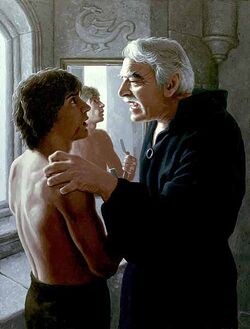
Dracula tries to resist drinking from Harker's shaving cut.
Dracula at first charms Jonathan with his cordiality and historical knowledge and even rescues him from the clutches of his three bloodthirsty brides. In truth, however, Dracula wishes to keep him alive just long enough for his legal transaction to finish, to learn as much as possible about England and perfect his elocution, as a wealthy nobleman like him would not bear to be seen as another foreigner with a funny accent.
Jonathan notices that something is amiss when he cuts himself while shaving, due to the lack of mirrors in the castle, as the Count gets enthralled by the smell of blood and and comes really close to draining his blood. He later witnesses Dracula crawling along the castle walls and resting in his vault, but realizes upon trying to flee that he is a prisoner.
He later asks Dracula's gypsy servants to take his letters to the post office, but they laugh off his pleas and give the letters to Dracula. He also witnesses a woman demand for her child, whom Dracula abducted for his brides, but the Count calls forth wolves to tear her apart. Dracula leaves Jonathan to die in his castle, but he manages to climb down the walls and reach a convent, where the nuns nurse him back to health.
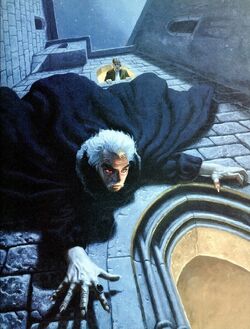
Dracula then boards a Russian ship, the Demeter, bringing along 50 crates of Transylvanian soil. During the voyage to Whitby, a coastal town in northern England, he sustains himself on the ship's crew members and throws them at sea. Only the body of the captain is later found, tied up to the ship's helm. The captain's log is recovered and tells of strange events that took place during the journey. Dracula leaves the ship in the form of a very large black dog.
Soon the Count is menacing Harker's devoted fiancé, Wilhelmina "Mina" Murray, and her vivacious friend, Lucy Westenra. There is also a notable link between Dracula and Renfield, a patient in an insane asylum compelled to consume insects, spiders, birds, and other creatures — in ascending order of size — in order to absorb their "life-force". Renfield can detect Dracula's proximity and supply clues accordingly. Dracula quickly gains Renfield's obedience and starts visiting Lucy's bedroom each on a nightly basis, draining her of blood.
Unable to stop Lucy's deterioration, her unfortunate suitor Dr. John Steward, the director of the Asylum where Renfield is kept, calls his former mentor the Dutch doctor Abraham Van Helsing. Van Helsing soon deduces her condition's supernatural origins, but does not speak out, knowing that he cannot prove it.
Despite an attempt at keeping the vampire at bay with garlic, Dracula watches Lucy under the shape of a bat and later transforms into a wolf in an attempt to break into Lucy's house, violently scaring Lucy's mother who dies of heart failure. He later returns and entices Lucy out of her chamber late at night, draining her blood and killing her.
It appears that Lucy is now a vampire herself, and is preying upon children, who call her the "Bloody Maiden". Van Helsing leads Dr. Steward, the Texan Quincey Morris (another of Lucy's unfortunate suitors) and Lucy's fiancé Lord Arthur Godalming into Lucy's crypt, to reveal the truth and relieve her from undeath. They later join forces with Jonathan and Mina, who just returned to England and are now married, and swear to destroy the Count.
They gather their information and start using it to track down Dracula. They quickly learn that the Count had his fifty crates of Transylvanian soil brought to Carfax Abbey, his house in the Purfleet Domain. When the protagonist storm Carfax Abbey for recognition, they discover that only 29 crates are left there. The Count unleashes a horde of rats against them, but they keep the critters at bay with attack dogs. It now becomes clear that Dracula has hired many solicitors to purchase three more houses in London, and dispersed the rest of his crates there.
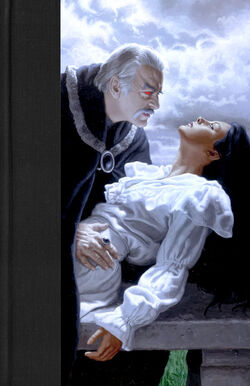
Dracula drains Mina.
Dracula enters the Asylum, where Mina resides, invited by Renfield, and starts feeding on her. He trashes Stewart's study and destroys everything they wrote about him to keep them away, but fortunately they kept copies in a safe. Dracula later kills Renfield, who tried to protect Mina out of gratitude for her kindness, hypnotizes Jonathan to neutralize him and threatens to kill him should Mina resist, before feeding on her and infecting her with vampirism. The other protagonists drive him away with crosses and holy symbols, but with Mina infected they are now running against time.
The protagonists resolve to track down Dracula before he can purchase more, which would make it almost impossible to track him down. After a long investigation, they discover Dracula's other hideouts and take profit of the day to destroy all his crates by putting holy wafers in the earth.
They destroy the crates in Carfax Abbey, and later the ones his remaining hideouts, but it appears that Dracula has taken one away. Mina later warns them by telegraph that Dracula has discovered what they did in Carfax and is now checking all his residences. The protagonists regroup in Dracula's last residence and wait for him to try and destroy him while they can.
As soon as Dracula comes in, Jonathan attacks him with his large kukri knife but he manages to flee, cursing them. Dracula later fetches his only remaining box and rents a boat to return to Transylvania, in order to lay low for a few decades and plan a second, best organized invasion of England.
While the protagonists worry that Dracula would bury his remaining crate and hide away until Mina becomes a vampire, Mina urges Van Helsing to hypnotize her, taking profit of her connection with the Count to discover that he has boarded a ship. Lord Godalming learns the ship's name and the group decides to reach Transylvania before him by land to ambush him. However, Dracula influenced the weather to make the trip unnaturally fast and faked the ship's destination to launch them on a false track. They rush after him, but too late. They attempt to track him down, but he has killed the man he hired for his travel towards his castle to cover his track, and severed his psychic link with Mina.
Mina deduces that Dracula is traveling by boat on the river, and cannot reveal himself out of fear that the sailors would throw his crate in the river and kill him. The men chase after the vampire, while Mina and Van Helsing precede them to the castle. At night, Van Helsing puts Mina inside a circle of holy wafers to protect her from both Dracula's influence and her growing vampirism. The following night, they ward off Dracula's brides. In the morning, Van Helsing ventures in the castle, using a map drawn by Jonathan, and destroys the brides, before ruining Dracula's last resting place and using holy wafers to prevent him from entering his castle ever again.
Later, the men catch up with Dracula's gypsy bodyguards while Mina and Van Helsing ambush them from behind. After a short battle during which Quincey gets mortally wounded, Jonathan and Quincey manage to break Dracula's crate open. Just before the night would enable the Count to rise and terminate his foes, Quincey pierces his heart with his huge bowie knife while Jonathan beheads him with his Kukri. (Mina Harker's Journal, 6 November, Dracula Chapter 27) Quincey passes away with a smile, happy to notice than Mina is freed from Dracula's curse.
The fact that he was not "properly" staked has led some to doubt whether Dracula has really been finished off, and to even believe that he shall rise again. However, Dracula crumbles into dust with an expression of blissful relief on his face, exactly like the other destroyed vampires, and Mina loses all the physical and mental stigma caused by vampirism, proving without any doubt that Dracula was truly dead and gone.
Gallery
| | ||
|
Main Icons Others | ||
Template:Approved Evil Articles Navigation |}

